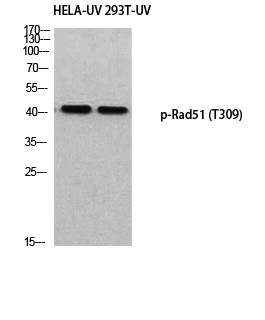Total RAD51 Cell-Based Colorimetric ELISA Kit
- Catalog No.:KA4261C
- Applications:ELISA
- Reactivity:Human;Mouse
- Gene Name:
- RAD51
- Human Gene Id:
- 5888
- Human Swiss Prot No:
- Q06609
- Mouse Swiss Prot No:
- Q08297
- Storage Stability:
- 2-8°C/6 months
- Other Name:
- DNA repair protein RAD51 homolog 1 (HsRAD51) (hRAD51) (RAD51 homolog A)
- Detection Method:
- Colorimetric
- Background:
- disease:Defects in RAD51 are associated with breast cancer (BC) [MIM:114480].,function:May participate in a common DNA damage response pathway associated with the activation of homologous recombination and double-strand break repair. Binds to single and double stranded DNA and exhibits DNA-dependent ATPase activity. Underwinds duplex DNA and forms helical nucleoprotein filaments.,PTM:Phosphorylated. Phosphorylation of Thr-309 by CHEK1/CHK1 may enhance association with chromatin at sites of DNA damage and promote DNA repair by homologous recombination.,similarity:Belongs to the recA family.,similarity:Belongs to the recA family. RAD51 subfamily.,similarity:Contains 1 HhH domain.,subcellular location:Colocalizes with RAD51AP1 to multiple nuclear foci upon induction of DNA damage.,subunit:Interacts with BRCA1, BRCA2 and either directly or indirectly with p53. Interacts with XRCC3, RAD54L and RAD54B. Part of a complex with RAD51C and RAD51B. Interacts with RAD51AP1 and RAD51AP2. Interacts with CHEK1/CHK1, and this may require prior phosphorylation of CHEK1. Interacts with the MND1-PSMC3IP heterodimer (By similarity). Interacts with OBFC2B.,tissue specificity:Highly expressed in testis and thymus, followed by small intestine, placenta, colon, pancreas and ovary. Weakly expressed in breast.,
- Function:
- M phase, double-strand break repair via homologous recombination, recombinational repair, DNA metabolic process,DNA replication, DNA-dependent DNA replication, DNA unwinding during replication, DNA repair, double-strand break repair, DNA recombination, mitotic recombination, protein complex assembly, response to DNA damage stimulus, cell cycle, meiosis, meiosis I, reciprocal meiotic recombination, positive regulation of macromolecule metabolic process, cell cycle process, cell cycle phase, DNA geometric change, DNA duplex unwinding, cellular response to stress,macromolecular complex subunit organization, positive regulation of nucleobase, nucleoside, nucleotide and nucleic acid metabolic process, regulation of DNA metabolic process, positive regulation of DNA metabolic process, regulation of DNA ligation, positive regulation of DNA ligation, positive regulation of nitrogen compound metab
- Subcellular Location:
- Nucleus . Cytoplasm . Cytoplasm, perinuclear region. Mitochondrion matrix . Chromosome . Cytoplasm, cytoskeleton, microtubule organizing center, centrosome . Colocalizes with RAD51AP1 and RPA2 to multiple nuclear foci upon induction of DNA damage (PubMed:20154705). DNA damage induces an increase in nuclear levels (PubMed:20154705). Together with FIGNL1, redistributed in discrete nuclear DNA damage-induced foci after ionizing radiation (IR) or camptothecin (CPT) treatment (PubMed:23754376). Accumulated at sites of DNA damage in a SPIDR-dependent manner (PubMed:23509288). Recruited at sites of DNA damage in a MCM9-MCM8-dependent manner (PubMed:23401855). Colocalizes with ERCC5/XPG to nuclear foci in S phase (PubMed:26833090). .
- Expression:
- Highly expressed in testis and thymus, followed by small intestine, placenta, colon, pancreas and ovary. Weakly expressed in breast.
- June 19-2018
- WESTERN IMMUNOBLOTTING PROTOCOL
- June 19-2018
- IMMUNOHISTOCHEMISTRY-PARAFFIN PROTOCOL
- June 19-2018
- IMMUNOFLUORESCENCE PROTOCOL
- September 08-2020
- FLOW-CYTOMEYRT-PROTOCOL
- May 20-2022
- Cell-Based ELISA│解您多样本WB检测之困扰
- July 13-2018
- CELL-BASED-ELISA-PROTOCOL-FOR-ACETYL-PROTEIN
- July 13-2018
- CELL-BASED-ELISA-PROTOCOL-FOR-PHOSPHO-PROTEIN
- July 13-2018
- Antibody-FAQs

